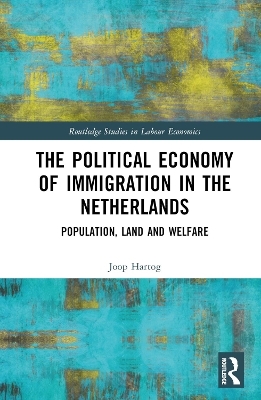
The Political Economy of Immigration in The Netherlands
Population, Land and Welfare
Seiten
2023
Routledge (Verlag)
978-1-032-44758-2 (ISBN)
Routledge (Verlag)
978-1-032-44758-2 (ISBN)
Presents a historical perspective on the development of population density in The Netherlands, offering a broad survey of the conventional approach to measuring immigration’s effects and also considering better measures of welfare and providing a detailed description and evaluation of policies - rules, regulations and implementation.
Economists measure the effects of immigration through the yardstick of income. This book offers a broad survey of the conventional approach but in addition, also considers better measures of welfare or well-being and provides a detailed description and evaluation of policies - rules, regulations and implementation.
The book offers a long, historical perspective on the development of population density in the Netherlands. It begins with the history of the Netherlands: geological and cultural formation of the land - and water - and population development. The Netherlands is unique in that much of the land is man-made, in particular the western part, which is, economically speaking, the most developed area. It is also special for its very high population growth rate that took off during the 19th century.
The key argument of the book is that population size is irrelevant for income per capita, that land is a binding constraint in the Netherlands and that negative external effects of increasing population size lead to welfare losses from further population growth, whether by natural growth or by immigration. At present, the battle for scarce land is intense and bitter, with a strong clash between developers who want to build houses, farmers who do not want to give up farming and conservationists who increasingly find support in the courts for insufficiently caring for the natural environment.
The book combines a general analysis of population density, both theoretical and empirical, with an in-depth presentation of actual policies in a country with intense pressure on available land.
Economists measure the effects of immigration through the yardstick of income. This book offers a broad survey of the conventional approach but in addition, also considers better measures of welfare or well-being and provides a detailed description and evaluation of policies - rules, regulations and implementation.
The book offers a long, historical perspective on the development of population density in the Netherlands. It begins with the history of the Netherlands: geological and cultural formation of the land - and water - and population development. The Netherlands is unique in that much of the land is man-made, in particular the western part, which is, economically speaking, the most developed area. It is also special for its very high population growth rate that took off during the 19th century.
The key argument of the book is that population size is irrelevant for income per capita, that land is a binding constraint in the Netherlands and that negative external effects of increasing population size lead to welfare losses from further population growth, whether by natural growth or by immigration. At present, the battle for scarce land is intense and bitter, with a strong clash between developers who want to build houses, farmers who do not want to give up farming and conservationists who increasingly find support in the courts for insufficiently caring for the natural environment.
The book combines a general analysis of population density, both theoretical and empirical, with an in-depth presentation of actual policies in a country with intense pressure on available land.
Joop Hartog is Emeritus Professor of Economics at the University of Amsterdam, The Netherlands.
1. Introduction 2. Man, land and water: A brief history of Dutch density 3. Population size, immigration and income per capita 4. Measuring effects on welfare 5. The political economy of immigration 6. The upshot: tough policy challenges
| Erscheinungsdatum | 22.08.2023 |
|---|---|
| Reihe/Serie | Routledge Studies in Labour Economics |
| Zusatzinfo | 14 Tables, black and white; 9 Line drawings, black and white; 2 Halftones, black and white; 11 Illustrations, black and white |
| Verlagsort | London |
| Sprache | englisch |
| Maße | 156 x 234 mm |
| Gewicht | 380 g |
| Themenwelt | Sozialwissenschaften ► Politik / Verwaltung |
| Sozialwissenschaften ► Soziologie ► Mikrosoziologie | |
| Sozialwissenschaften ► Soziologie ► Spezielle Soziologien | |
| Wirtschaft ► Volkswirtschaftslehre ► Wirtschaftspolitik | |
| ISBN-10 | 1-032-44758-3 / 1032447583 |
| ISBN-13 | 978-1-032-44758-2 / 9781032447582 |
| Zustand | Neuware |
| Haben Sie eine Frage zum Produkt? |
Mehr entdecken
aus dem Bereich
aus dem Bereich


